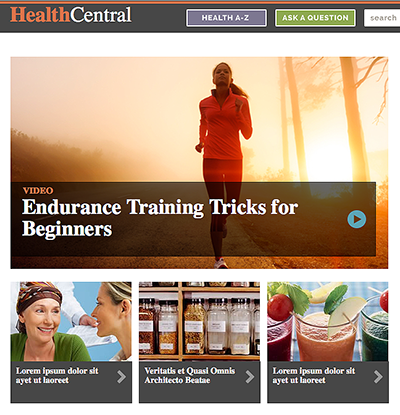Having taken the lead over rivals WebMD and Everyday Health in some measures of patient engagement, Remedy Health is hoping a new-look website can help it further turn the tide in the portal wars.
Remedy’s flagship site, HealthCentral.com, is scheduled for a major re-launch later this year incorporating what the publisher considers a more attractive design, friendlier site architecture, and other cutting-edge features it says are lacking in healthcare but are all too common among portals produced outside this industry (a prototype is pictured).
The upcoming site, set to go live in the fourth quarter, will also feature responsive design enabling a consistent viewing experience across devices. Enhancements are aimed at boosting engagement with those whom search streams show make up Remedy’s core audience—real patients.
“All consumer health sites are set up in the same confusing way,” Jim Curtis, Remedy’s chief revenue officer, told MM&M in an exclusive interview. “In health, people want innovation on a website—responsive design, in-line video. And if you give it to them in a format they’re used to using, there’s more engagement.”
The typical HealthCentral visitor, Curtis said, is someone with a question such as “What can I eat if I have psoriasis?”
“We will never come up number-one [in search results] for ‘rash,’” he said. “These are people who are treating and who want to cope with a disease.”
Remedy already has a leg up when it comes to connecting with its target base. According to Manhattan Research’s Cybercitizen Health 2012 survey, it’s leading its two major rivals in terms of percent of users who use the internet to prepare for a doctor’s visit or when considering switching to a new medicine.
Forty percent of Remedy Health Media visitors have gone online for health info or tools to prep for a doctor visit, the survey showed, vs. 36% of Everyday Health Network users and 26% of those on WebMD Network. Twenty-nine percent of Remedy Health Network visitors have gone online for health information or tools when they were considering switching to a different Rx drug, vs. 24% for Everyday Health Network users and 18% of WebMD Network users.
Moreover, 85% percent of Remedy Health users said the web influenced a health treatment or service decision, vs. 73% of Everyday Health Network users and 66% of WebMD Network users, according to the Manhattan Research survey.
In addition to several million monthly unique visitors, Remedy’s network of roughly 300 bloggers and patient experts contributes to the higher interaction rates. According to Omniture stats, 78% of users’ questions are answered by Remedy experts, and visitors are five times more likely to share content from one of these mavens than from non-expert community members.
Remedy is less dependent on advertising revenue than its rivals are, having established a healthy sideline in subscriptions and licensing deals with health plans and hospitals.
With longtime partner the University of California-Berkeley School of Public Health, Remedy launched a health and wellness platform—BerkeleyWellness.com—in February, leveraging the relationship. A dozen or so in-house Remedy editors also collaborate with The Johns Hopkins University School of Medicine on content.
Nevertheless, it’s also hoped that the new design cues boost the privately owned firm’s digital advertising, which has more than doubled the last two years, Curtis said. “If it’s good for the patient, it’s good for advertisers.”







